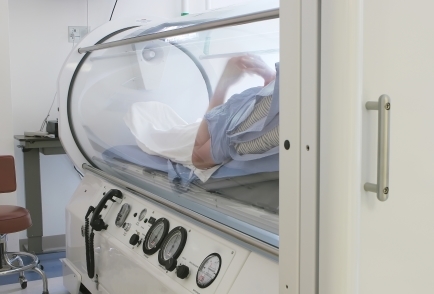Hyperbaric Oxygen Therapy
Hyperbaric medicine, also known as hyperbaric oxygen therapy (HBOT), is the medical use of oxygen at a level higher than atmospheric pressure. The equipment required consists of a pressure chamber, which may be of rigid or flexible construction, and a means of delivering 100% oxygen. The operation is performed by a predetermined schedule by trained personnel who monitors the patient and may adjust the schedule, as required. HBOT found early use in the treatment of decompression sickness. But it has also shown great effectiveness in treating conditions such as gas gangrene and carbon monoxide poisoning. More recent research has examined the possibility that it may also have value for other conditions such as cerebral palsy, multiple sclerosis, wound healing, autism, total rejuvenation from the cellular level and helps a variety of additional health conditions.

Hyperbaric Oxygen Therapy (HBOT)
All About Hyperbaric Therapy or Hyperbaric Oxygen Therapy (HBOT)
Hyperbaric chambers, used in Hyperbaric Therapy or HBOT are any number of enclosures, which can be pressurized to allow a person inside to experience higher atmospheric pressures than the normal environmental pressures. For example, a treatment at an elevation of 12,000 feet above sea level using a 4 psi (1.27 ATA) can simulate a decent of ~5,843 feet to 6,157 feet above sea level.
At higher elevations, the barometric pressure is lower. This decrease of pressure also decreases the oxygenation of blood, and is known as anoxia—where molecules of oxygen exert less pressure on the walls of the alveoli (Dalton's Law). HBOT follows this law.
How does Hyperbaric Oxygen Therapy (HBOT) work?
Hyperbaria - Increased atmospheric pressure as a means of increasing
oxygen uptake without an enriched oxygen source
Hyperoxia - Increased total oxygen content
Hyperbaria is based on the concept of the relationship of gas pressure and uptake in liquids (blood, plasma and tissues). Henry's Law states that "a gas is dissolved by a liquid in direct proportion to its partial pressure." For example, at sea level, atmospheric pressure is 760 mm Hg, the oxygen concentration is 21% and the body's oxygen content or partial pressure, pO2, in blood and plasma is ~ 40 mm Hg.
Red blood cells have a limitation as to how much oxygen can bind with hemoglobin. The plasma portion of the blood typically has about a 3% oxygen concentration. By placing someone in a 3 psi pressure hyperbaric environment, the increase in atmospheric pressure at sea level goes from 760 mm Hg to 915 mm Hg. This increase in gas pressure, increases the partial pressure of the oxygen gas and thus forces more oxygen to be dissolved in the plasma. This saturation of oxygen in the blood that occurs due to the HBOT terapy allows the extra oxygen to be diffused or transported to the surrounding body tissues. Thus, oxygen transport by plasma is significantly increased under this specialized treatment. At three atmospheres pressure, enough oxygen can be dissolved in the plasma to support the oxygen demands of the body at rest in the absence of hemoglobin!
HBOT is designed to boost the supply of oxygen to ischemic tissue or to diseased tissues that respond to increased oxygen levels. Increasing the volume of oxygen dissolved in the blood plasma,that is brought about by HBOT treatment, produces five basic effects:
• Reduction of volume of gas bubbles in the blood
• Vasoconstriction, which reduces edema and secondary hypoxia
• Restoration of aerobic metabolism to ischemic tissue
• Detoxification of poisoned tissues
• Enhanced phagocytosis
Henry's Law- Henry's law states that for a gas-liquid interface the amount of the gas that dissolves in the liquid is proportional to its partial pressure. So Henry's law helps to predict how much gas will be dissolved in the liquid. The actual amount also depends on the solubility of the gas as well as its partial pressure. Dalton's Law-John Dalton observed that the total pressure of a gas mixture was the sum of the pressures of each of the gases if they were to exist on their own.
Conditions Treated with Hyperbaric Oxygen Therapy with effective clinical research outcomes
HBOT is FDA approved to treat the following conditions:
Air or Gas Embolism
Carbon Monoxide Poisoning / Cyanide Poisoning
Crush Injury / Acute Traumatic Ischemia
Decompression Sickness
Delayed Radiation Injury
Diabetic Foot Ulcers
Enhanced Healing of Problem Wounds
Exceptional Blood Loss
Gas Gangrene
Intracranial Abcess
Necrotizing Soft Tissue Infections
Osteomyelitis (Refractory)
Skins Grafts & Flaps (Compromised)
-
Thermal Burns
Portable hyperbaric chambers are cleared by the FDA for the treatment of acute mountain sickness.
Internationally, HBOT is used to treat a wide variety of conditions that are considered investigational in the U.S.
Common International Uses:
ADD (Attention Deficit Disorder)
ALS (Amyotrophic Lateral Sclerosis)
Alzheimer’s
Anti-Aging
Athletic Conditioning
Arthritis (Osteoarthritis & Rheumatoid)
Asperger’s
Autism
Autism Spectrum Disorder
Auto-Immune Disorders
Brain Injury (Encephalopathy)
Burns
Cancer
Cerebral Palsy
CFS (Chronic Fatigue Syndrome)
Chronic Pain
Coma
Cosmetic Surgery (Post-Surgery Healing)
Crohn’s Disease
Dementia
Disease Prevention
Epilepsy
Fetal Alcohol Syndrome
Fibromyalgia
Heart Disease
Infection
Common International Uses Cont’d.
Injury Healing
Insomnia
Lyme Disease
Memory Loss
Migraines
Mitochondrial Disorders
Multiple Chemical Sensitivity
Multiple Sclerosis
Near Drowning
Neuropathy
Parkinson’s
RLS (Restless Legs Syndrome)
RSD (Reflex Sympathetic Dystrophy)
Seizure Disorders
Skin Care
Sports Injury Healing
Stem Cell Therapy (Pre and Post Stem Cell Therapy)
Stroke
Plastic Surgery (Post-Surgery Healing)
Post Surgery Healing
Pre-Surgery
Traumatic Brain Injury
Toxic Brain Injury
-
Wound Healing
Less Common International Uses:
Addiction
AIDS & HIV
Allergies & Asthma
Atherosclerosis
Bell’s Palsy
Depression
Diabetes
Down Syndrome
Erectile Dysfunction
Frostbite
Gulf War Syndrome
Hearing Loss
Hepatitis
Huntington’s
Infertility
Interstitial Cycstitis
Kidney Disease
Lupus
Macular Degeneration
Menopause Symptoms
Meningitis
Morgellons
Myasthenia Gravis
Ocular (Eye) Conditions
Orthopedic
Osteoporosis
Pancreatitis
Less Common International Uses Cont’d.